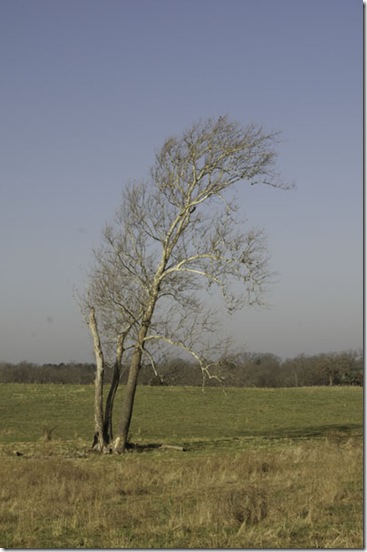The woods here are greening. In the understory the wild rose bushes, buckbrush, and honeysuckle vines are leafing out. The willows and elms already have tiny leaves, and even the buds on the oaks are swelling. Oddly, these signs of spring have made me realize something I’ll miss about winter.
I’ll miss the tree skeletons, the bare bones that expose the true framework of the tree. In winter, trees are naked, scars and flaws exposed for all to see. There’s no hiding the dead, rotting limb or the hollow where the woodpeckers have nested. Those who know trees well can identify at a tree such as this at a glance. They can tell by its shape and bark color that it’s a sycamore, and that it’s quite old.
This sycamore presides over a hay meadow that sometimes floods, and nearby is another that’s nearly as large. It’s not uncommon to find these grand old sycamores near waterways and in flood-prone fields. This photo really doesn’t do this grand old tree justice. I had no way that day to show how very thick that trunk was – I doubt I could wrap my arms even halfway around it. As the meadow was guarded by large dogs, I wasn’t tempted to measure it that day.
About a mile away, on higher ground this weather worn sycamore has a harder life. It’s more exposed to the wind and hasn’t the constant source of moisture of the creek.
I love this lop-sided oak with its bare back and thickly-branched front. It grows at the edge of a gravel road near our farm, and I’m sure you can guess which faces the road and has thus been gifted with more sunlight. The back side is no longer heavily shaded by what must have been even grander oaks at one time, so it looks stranger than than it would have if it were still the outer edge of a cluster of big trees.
I grew up among forests of oaks and maples, and those are the trees that I identify clearly, without a doubt, without second thought, even in winter. Their shapes are as familiar as the faces of my parents and grandparents. I recognize a few others easily, even from a distance: Osage Orange, willow, and birch. Others I knew in summer when there were leaf shapes to guide me, but in winter required more thought and the help of a guide book. So it’s become a challenge to expand my tree lore, to learn to recognize more varieties at a glance from a distance. I’ve added elm, pecan, walnut and locust to my repertoire of trees I recognize at a glance in winter. I’m working on others. For now though, with regret, I must set that particular study aside because the season is turning and the trees are putting on their spring clothes.
I do still have a little time left to enjoy my favorite sunset tree since oaks leaf out later than most other trees.
FYI – my two favorite references for winter tree identification are the Audubon Society Field Guide to North American Trees (Eastern Region) and A Key to Missouri Trees in Winter. The Audubon guide is excellent for other seasons as well and serves as my primary summer tree guide. I also like the Peterson Field Guide to Trees and Shrubs and Trees of Missouri.







The best thing about tree skeletons is that they’re still there, and they’ll be back too.
They do look really cool when you have the skeletons just starting to bud, though.
These are such lovely pictures. I love to draw tree skeletons. These have so much character.